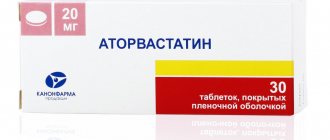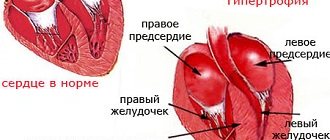Combination therapy for arterial hypertension
In Russia, 40% of men and women over 18 years of age have elevated blood pressure levels
(BP) [5].
The most important condition for effective antihypertensive therapy is adequate blood pressure control, i.e., achieving its target level, which is taken to be blood pressure <140/90 mm Hg. in all patients with hypertension. If the prescribed therapy is well tolerated, reducing blood pressure to lower values is considered useful. When hypertension is combined with diabetes mellitus or kidney damage, it is recommended to reduce blood pressure to a level of less than 130/80 mm Hg. [6]. However, in Russia, only 5.7% of men and 17.5% of women with hypertension achieve target blood pressure levels. Only 59% of women and 37% of men are aware of the existence of hypertension, only 46% of women and 21% of men are treated, but target blood pressure values are achieved only in 17.5% of women and 5.7% of men [7,8]. Thus, modern antihypertensive therapy should act on various systems through which blood pressure is regulated in the human body: the sympathetic-adrenal system, the renin-angiotensin-aldosterone system (RAAS), calcium metabolism, sodium-volume [9]. Influencing any of them allows you to achieve a decrease in blood pressure. According to the results of the meta-analysis BPLTTC-2003
(Blood Pressure Lowering Treatment Trialist Collaboration), four classes of antihypertensive drugs acting on different systems - angiotensin-converting enzyme inhibitors (ACE inhibitors), diuretics, β-blockers, calcium channel blockers showed equal effectiveness in preventing the development of cardiovascular events.
Currently, it is possible to use two strategies for treating hypertension to achieve target blood pressure: monotherapy and combination treatment. However, the results of many prospective clinical trials of antihypertensive therapy convincingly show that in the vast majority of cases it is impossible to achieve target blood pressure values with monotherapy. Each of these approaches has its own advantages and disadvantages. The advantage of monotherapy is that if the drug is successfully selected, the patient will not need to additionally take another drug. However, as a rule, with monotherapy it is possible to achieve target blood pressure on average only in 30–40% of patients with hypertension. This is quite natural, since one class of drugs is not able to control all pathogenetic mechanisms of increased blood pressure: the activity of the sympathetic nervous system and the renin-angiotensin-aldosterone system, volume-dependent mechanisms. Specifically, in the HOT
At study entry, 59% of patients were receiving monotherapy, whereas after 3.2 years only 32% of patients were taking a single antihypertensive drug. At the same time, there was a clear relationship between the target DBP and the frequency of combination therapy. To achieve DBP<90 mm Hg. combination therapy was required in 63% of cases, DBP<85 mmHg. – in 68%, and for DBP<80 mm Hg. – in 74% (and the average DBP in this group was 81 mm Hg, i.e., the goal was not achieved) [10]. The frequency of prescription of two or more antihypertensive drugs in other studies was also high: in the SHEP study - 45.0%, MAPHY - 48.5%, ALLHAT - 62.0%, STOP-Hypertension - 66.0%, IPPPSH - 70, 0%, INVEST – 84.0%, LIFE – 92.0%, COOPE – 93.0%, and in the VA study the combination was required in all patients.
The disadvantage of combination therapy is the inconvenience associated with the fact that the patient has to additionally take one more, and sometimes several, drugs. However, in most cases, the prescription of antihypertensive drugs with different mechanisms of action allows, on the one hand, to achieve target blood pressure, and on the other hand, to minimize the number of side effects. Combination therapy also makes it possible to suppress counterregulatory mechanisms of increased blood pressure. The use of a combination of antihypertensive drugs becomes undeniable, especially in the treatment of high-risk hypertension, in patients with kidney damage, in patients with diabetes mellitus, for whom target blood pressure values are lower. Initiation of treatment with a combination of drugs is most preferable in patients with lower target blood pressure values, with high and very high risk hypertension, as well as with a pronounced increase in blood pressure (160/100 mm Hg and above). In the latter case, the need to prescribe a combination of drugs is in most cases supported by American recommendations (Report of the Joint Committee, 2003).
There are various combinations of antihypertensive drugs. Among the combinations of two drugs, the following are considered effective and safe:
diuretic + β-blocker;
diuretic + ACE inhibitor; diuretic + angiotensin II receptor antagonist (ARA); dihydropyridine calcium antagonist + β-blocker; calcium antagonist + ACE inhibitor; calcium antagonist + diuretic; α-adrenergic blocker + β-adrenergic blocker; centrally acting drug + diuretic. In addition, combinations of an ACE inhibitor, calcium antagonist, ARB and diuretic with an I1 imidazoline receptor agonist are possible. The most popular in Russia is the combination of an ACE inhibitor and a diuretic. As the results of the PYTHAGORUS
, almost a third of doctors in Russia prefer a combination of these drugs [11]. The advantages of combination therapy include: enhanced antihypertensive effect due to mutual potentiation of the effect of individual drugs. This occurs due to the suppression of various pressor systems, as well as the neutralization of counter-regulatory mechanisms that reduce the effectiveness of individual drugs. Reducing the frequency of adverse events: firstly, mutual potentiation of the antihypertensive effect allows the use of lower doses of drugs in combinations, which reduces the frequency of side effects; secondly, most rational combinations ensure mutual neutralization of the side effects of individual drugs. Increased response rate to treatment and rate of achievement of target blood pressure levels. A combination of drugs that blocks multiple mechanisms for maintaining elevated blood pressure increases the likelihood of affecting the pressor system that is most active in a given patient. Prescribing combination therapy doubles the likelihood of response to treatment. This ensures more effective protection of the target organs of hypertension and, consequently, a more pronounced reduction in the risk of complications.
The combination of an ACE inhibitor and a diuretic is one of the most reasonable and convenient
.
Today it has been proven that ACE inhibitors and diuretics act synergistically and the effect of this combination is higher than that of each of these drugs separately. Diuretics, by reducing the volume of circulating blood, lead to compensatory activation of the renin-angiotensin-aldosterone system (RAAS), which limits their effectiveness. The addition of ACE inhibitors overcomes the activation of the RAAS and thereby enhances the effect of the diuretic. On the other hand, it is known that ACE inhibitors are less effective in the low-renin form of hypertension. Adding a diuretic in this situation increases the activity of the RAAS and increases the effectiveness of ACE inhibitors. The combined use of an ACE inhibitor and a diuretic makes it possible to mutually neutralize the side effects of both drugs. Diuretics lead to increased potassium excretion, while ACE inhibitors promote potassium retention; Accordingly, the combination provides prevention of both diuretic-induced hypokalemia and ACE inhibitor-induced hyperkalemia. Prevention of hypokalemia can be significant not only in terms of increasing tolerability of therapy. SHEP
study, patients with hypokalemia did not show a reduction in the incidence of adverse cardiovascular events compared with patients with normokalemia, despite the same reduction in blood pressure [12]. It is known that thiazide diuretics, in addition to hypokalemia, cause hyperuricemia, while ACE inhibitors help reduce it, because increase blood flow in the renal cortical layer, which leads to increased excretion of uric acid. A significant disadvantage of thiazide diuretics is their adverse effect on lipid and glucose metabolism. Combining diuretics with ACE inhibitors can reduce these undesirable effects, but often prevents them from being completely overcome.
Thus, in the Russian study EPIGRAPH
[13] assessed the effectiveness of a non-fixed combination of the ACE inhibitor enalapril and the thiazide diuretic indapamide.
The study involved 30 centers, which included 550 patients suffering from hypertension or secondary hypertension of renal origin with blood pressure levels above 160 and 90 mm Hg. The average age of those examined was 55.3±0.4 years; among those observed there were 319 (58%) women and 231 (42%) men. Initial blood pressure values averaged 174.1 and 100.6 mm Hg, arterial hypertension II. was observed in 452 (82%), stage III hypertension. – in 98 (18%) patients. Symptomatic renal hypertension (against the background of pyelonephritis or glomerulonephritis) was recorded in 198 (36.8%) patients. All patients were prescribed indapamide at a dose of 2.5 mg/day. Then all patients were divided into three groups depending on their SBP. In group 1 (124 patients) SBP was 160–170 mm Hg, in group 2 (328 patients) – 170–180 mm Hg, in group 3 (98 patients) >180 mm Hg .st. Patients in group 1 were prescribed enalapril at a dose of 5 mg/day, patients in group 2 – 10, and patients in group 3 – 20 mg/day. If target blood pressure levels were not achieved, enalapril doses were increased, which was required in 121 (22%) patients. As a result, the average daily dosage of enalapril at the end of the study was 15.2 mg in combination with indapamide at a dose of 2.5 mg. During the study, in the group as a whole, SBP decreased from 174.1±19.6 to 137.3 mmHg; the decrease was 38.8 mmHg, which corresponds to 20.4% of the initial value (p< 0.001). DBP also significantly decreased from 100.6±11.6 to 83.1±7.4 mmHg, the reduction amount was 17.5 mmHg, which corresponds to 14.7% of the initial level (p<0.001 ). The target blood pressure level was achieved in 385 out of 550 patients, i.e. in 70% of cases. The total indicator of blood pressure control, which included achieving target values in total with a decrease in blood pressure by 20/10 mm Hg. without achieving the target level was 77.1% (424 out of 550 patients). At the same time, a well-known pattern was noted: a decrease in DBP below 90 mm Hg. Art. was achieved in 521 (94.7%) patients, while SBP was below 140 mmHg. – only in 372 (67.7%). Combination therapy with enalapril and indapamide was well tolerated: side effects were detected in 45 (8.1%) patients, with symptoms associated with an excessive decrease in blood pressure predominant (5.4%), and only 15 (2.7%) patients had dry cough caused by taking enalapril. Thus, the combination of enalapril with indapamide was highly effective and the treatment was well tolerated
. It has been established that the effectiveness of combination therapy with enalapril and indapamide does not significantly depend on gender and age, as well as on the type of hypertension (essential or symptomatic). The proposed dosages of enalapril and indapamide generally provided a sufficient degree of effectiveness for hypertension of varying severity.
Based on the research, the drug Enzix
– an unfixed combination of enalapril and indapamide.
There are three types of Enzix: Enzix – 10 mg of enalapril and 2.5 mg of indapamide (single dose in the morning) for patients with stage I hypertension; Enisix Duo
– 10 mg enalapril and 2.5 mg indapamide (morning) + 10 mg enalapril (evening) for patients with stage II hypertension;
Enzix Duo Forte
– 20 mg enalapril and 2.5 mg indapamide (morning) + 20 mg enalapril (evening).
The effectiveness and safety of Enzix were assessed in the EPIGRAPH-2
, which was a comparative randomized multicenter study that included nine centers in Russia and one in Serbia [14]. A total of 313 patients were included in the study and randomized into two groups. The Enzix group included 211 patients, and the control group included 102 patients. The control group was treated with other classes of antihypertensive drugs (except ACE inhibitors and diuretics). The total duration of treatment was 14 weeks. All patients randomized to the Enzix group were divided into two subgroups depending on the initial blood pressure level. In the first subgroup, 118 patients with stage I hypertension and initial systolic blood pressure of 140–160 mm Hg. a combination of 10 mg enalapril and 2.5 mg indapamide (Enzix) was prescribed. During treatment, 88 (74.6%) of them continued to take the original dose, and in 26 (22.1%) patients the dose of enalapril was doubled (10 mg in the morning + 10 mg in the evening) while maintaining the dose of indapamide (2.5 mg in the morning ), which corresponded to Enzix Duo. Only one patient with stage I hypertension required a combination of 40 mg of enalapril (20 mg in the morning + 20 mg in the evening) and 2.5 mg of indapamide, which corresponded to Enzix Duo Forte. Three patients did not complete the study. In the second subgroup, 93 patients with stage II hypertension and systolic blood pressure of 160–180 mm Hg. therapy began with 20 mg enalapril (10 mg morning and evening) and 2.5 mg indapamide (Enzix Duo). During treatment, in 46 patients this dosage was maintained, and in 45 patients the dose of enalapril was increased to 40 mg/day. (20 mg in the morning + 20 mg in the evening) with a constant dose of indapamide 2.5 mg, which corresponded to Enzix Duo Forte. For two more patients, the initial dose of enalapril was reduced to 10 mg while maintaining the original dose of 2.5 mg of indapamide, which corresponded to Enzix.
When analyzing the number of patients whose blood pressure levels normalized as a result of treatment, the group of patients receiving Enzix (72.5%) had some advantages compared to the control group (66.7%). And this despite the fact that systolic blood pressure in the “experimental” group was initially 2.7 mm Hg. higher than in the control. If we sum up the total number of patients who responded positively to treatment (the number of patients with normalization of blood pressure or a decrease in systolic blood pressure by more than 20 mm Hg from the initial level), then by the end of treatment it reached 82.4% on average for the group, taking Enzix, and among patients with stage I hypertension this value was 89.8%, and in patients with stage II hypertension – 77.2%. Thus, early treatment of patients with grades I–II hypertension with a non-fixed combination of enalapril and indapamide (Enzix) in comparison with routine antihypertensive therapy makes it possible to achieve normalization of blood pressure levels more often. In addition, the Enzix group was able to significantly reduce the number of patients with left ventricular hypertrophy and proteinuria, improve quality of life, and reduce the number of hospitalizations and additional visits to the doctor.
It is known that fixed combinations, along with such advantages as ease of administration and increased adherence to treatment, also have disadvantages. In particular, the doctor cannot vary the doses of drugs included in a fixed combination, which does not allow individualization of treatment. If adverse reactions associated with one of the active principles occur, the combination as a whole must be discontinued. The presence of several dosage forms with different dosages allows these disadvantages to be overcome only partially. As a result, Enzix drugs were created, which are produced by Hemofarm AD and contain indapamide and enalapril tablets in one blister. The combination of drugs in one blister has a number of advantages: the possibility of titrating the dose of enalapril in various clinical situations, the ease of discontinuing the drug or reducing the dose if adverse events develop, the possibility of increasing the dose to enhance the antihypertensive effect by replacing the same form of the drug with a higher dosage of enalapril, which does not entail resulting in decreased adherence to treatment. The economic aspect of treatment also remains undoubtedly important. Thus, the drug Enzix with a non-fixed combination of enalapril and indapamide has established itself as a highly effective and safe drug for the treatment of arterial hypertension in various groups of patients.
References 1. Chobanian AV, Bakris GL, Black HR, et al. Seventh report of the joint national committee on prevention, detection, evaluation, and treatment of high blood pressure. Hypertension 2003;42:1206–52. 2. Shalnova S.A., Balanova Yu.A., Konstantinov V.V. and others. Arterial hypertension: prevalence, awareness, use of antihypertensive drugs and the effectiveness of treatment among the population of the Russian Federation // Russian Journal of Cardiology. 2006. No. 4. pp. 45–50. both nationally and globally 3. Ezzati M, Lopez AD, Rodgers A, et al. Selected major risk factors and global and regional burden of disease. Lancet 2002;360(9343):1347–60. The prevalence of hypertension in economically developed countries reaches 25% [1]. 1. Kaplan N, Schachter M. New frontiers in hypertension. Lippincatt Williams and Wilking 2002. 4. Lewington S, Clarke R, Qizilbash N, et al. Prospective Studies Collaboration. Age–specific relevance of usual blood pressure to vascular mortality: a meta–analysis of individual data for one million adults in 61 prospective studies. Lancet 2002;360:1903–13. 5. Oganov R.G. Prevention of cardiovascular diseases: opportunities for practical healthcare // Cardiovascular therapy and prevention. 2002. No. 1. P. 5–9. 6. Second revision of the VNOK recommendations for the prevention, diagnosis and treatment of arterial hypertension // Cardiovascular therapy and prevention. 2004. T. 3. No. 3. Part 1. P. 105–120. 7. Ratova L.G., Chazova I.E. Nephroprotective effect of antihypertensive therapy: the IRIS study. Consilium Medicum 2004; Appendix Issue 2; 3–7. 8. Fofanova T.V., Ageev F.T. ACE inhibitors plus low-dose thiazide diuretics: an ideal combination for the treatment of hypertension. Heart 2004; 3; 99–103. 9. Boytsov S.A. Combination therapy of arterial hypertension from the standpoint of prevention of cardiovascular complications and pathogenesis. Consilium Medicum 2004; Appendix Issue 2; 23–26. 10. Hansson L, Zanchetti A, Carruthers SG, et al. Effects of intensive blood–pressure lowering and low–dose aspirin in patients with hypertension: principal results of the Hypertension Optimal Treatment (HOT) randomized trial. Lancet 1998;351:1755–62. 11. Leonova M.V., Belousov Yu.B., Belousov D.Yu. and others. Results of a pharmacoepidemiological study of patients with arterial hypertension in Russia // Qualitative clinical practice. 2004. No. 1. P. 17–27. 12. Savage PJ, Pressel SL, Curb JD, et al. Influence of long-term, low-dose, diuretic-based, antihypertensive therapy on glucose, lipid, uric acid, and potassium levels in older men and women with isolated systolic hypertension: The Systolic Hypertension in the Elderly Program. Arch Intern Med 1998;158:741–51. 13. Belenkov Yu.N., Mareev V.Yu. on behalf of the EPIGRAPH study working group. Enalapril Plus Indapamide in the treatment of stable arterial hypertension: assessment of the effectiveness and safety of Rational Combination Pharmacotherapy (EPIGRAF). First results of a Russian multicenter study // Heart. 2003. T. 2. No. 4. P. 3–7. 14. Belenkov Yu.N. and the working group of the EPIGRAPH-2 study. Enalapril Plus Indapamide in the treatment of hypertension: assessment of the effectiveness and safety of Rational Pharmacotherapy. Use of a non-fixed combination of Enalapril and Indapamide (Enzix). Design and main results of the EPIGRAPH-2 study // Heart. 2005. T. 4. No. 5. P. 277–286.









